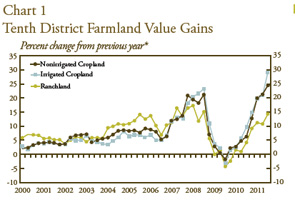WASHIGNTON, Nov. 16- Midwestern farmland values rose more than 25 percent in the third quarter of FY 2011, according to Federal Reserve Bank surveys.
Tenth District farmland values surged to a record high in the third quarter, with stronger gains in the northern Plains, according to the Federal Reserve Bank of Kansas City’s quarterly Survey of Agricultural Credit Conditions.
The Bank reported district cropland values rose more than 25 percent over the past year, and ranchland values increased 14 percent. A quarter of the 243 survey respondents felt that cropland values had yet to peak.
Nebraska posted the strongest gains with irrigated and nonirrigated land values rising approximately 40 percent above year-ago levels. Record gains in the northern Plains were fueled by another bumper crop this harvest season that raised farm income expectations despite the recent slide in crop prices, according to the Survey of Agricultural Credit Conditions.
The Federal Reserve Bank of Kansas City also reported that despite variable farm income, Tenth District agricultural credit conditions held steady in the third quarter. Loan repayment rates remained strong with fewer requests for loan renewals and extensions and interest rates for farm operating and real estate loans reached new survey lows.

The Federal Reserve Bank of Chicago reported the highest year-over-year increase in farmland values for the Seventh Federal Reserve District since the late 1970s, at 25 percent, for the third quarter of 2011. The value of “good” agricultural land in the third quarter of 2011 was 7 percent higher than in the second quarter, matching the highest previous quarterly gain since 1977.
According to the 216 bankers who responded to the October 1 survey, agricultural land values were poised to rise in the fourth quarter of 2011 as well. Further strengthening of agricultural credit conditions during the fall and winter was anticipated by respondents, reported the Federal Reserve Bank of Chicago in its monthly AgLetter.
“With 53 percent of the responding bankers expecting the volume of farm loan repayments would rise over the next three to six months compared with a year ago and just 3 percent expecting repayment rates would go down, current loan repayment trends should continue,” according to the AgLetter.
#30
For more news, go to www.agri-pulse.com
